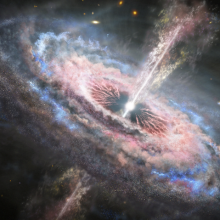Modern astronomers have speculated that, in the beginning, all galaxies formed in large halos of dark matter, a mysterious-yet-abundant substance that doesn't shine or interact with light.
These halos would have captured gas into gravitationally bound structures, turning about 20 percent of that gas into galaxy-residing stars.
But new research from the James Webb Space Telescope, a collaboration of NASA and its European and Canadian counterparts, is forcing scientists to rethink how galaxies formed in the early universe.
A team has discovered three ultra-massive galaxies near the beginning of time, seemingly contradicting the notion that the first space neighborhoods had to have been built rather clumsily. The scientists have referred to the ancient mammoth structures as "Red Monsters" because their high dust content makes them appear extremely red in Webb images, displayed at the top of this story.
The galaxies, each as vast as the Milky Way, are baffling because most scientific models for galaxy evolution suggest processes that would have been slow and inefficient, said Stijn Wuyts, an astronomer from the University of Bath in the United Kingdom.
"Yet somehow these Red Monsters appear to have swiftly evaded most of these hurdles," he said in a statement.

The trio of galaxies featured in the paper, published in the journal Nature on Wednesday, came together within the first billion years after the Big Bang, when the universe was still a toddler. Up until recently, theorists have believed a galaxy as large and advanced as the Milky Way would require many billions of years of evolution. The universe is estimated to be 13.8 billion years old.
The study is just the latest bit of mounting evidence to suggest that cosmologists have some work to do to better understand galaxies. Last month a separate team of scientists reported the discovery of REBELS-25, a galaxy that existed when the universe was only 700 million years old, yet is strikingly similar to the Milky Way.
Those researchers used the Atacama Large Millimeter/submillimeter Array, or ALMA, an observatory in Chile’s Atacama Desert, for their research. The structure, as described in Monthly Notices of the Royal Astronomical Society, could be the most distant rotating disk galaxy found so far.

In the new Nature study, scientists actually analyzed a sample of 36 massive dust-obscured galaxies. Though most of them didn't conflict with scientific models, the three ultra-massive standouts were found churning out stars nearly two times more efficiently — and thus faster — than smaller galaxies of the same period.
"Already in its first few years of operation, JWST has thrown us a couple of curveballs," Wuyts said. "In more ways than one, it has shown us that some galaxies mature rapidly during the first chapters of cosmic history."
Topics NASA













